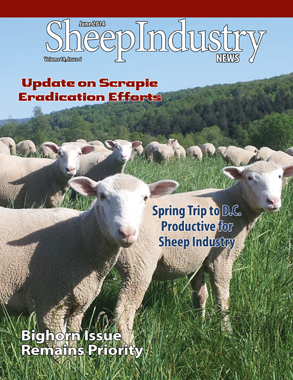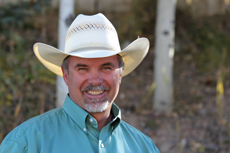
- June 2014
- President’s Notes
- Market Report
- Scrapie Eradication Remains Goal, but APHIS Hesitant About Timeline
- ASI Hosts Productivity Improvement Committee
- ASI’s 150th Blankets and Pillows Available Soon
- News Briefs
- Spring Trip to Nation’s Capital Called ‘Quite Productive’ for Sheep Industry
- Krebs Reminds Agency of NEPA Regulations in Bighorn Issue
- Superior Breaks Ground on New Facility
- Bighorn “Viability” Regulations Threaten Domestic Industry
- Running Rancher: Ken Wixom Brings Endurance to ASI’s Executive Board
- Study: Grouse Doing Well on Grazed Lands
- ‘Connect to Consumers’ Stressed During IWTO Congress
- Center of Nation Sale Features NSIP Sheep
- Obituaries
Bighorn “Viability” Regulations Threaten Domestic Industry
THEODORA DOWLING
Sheep Industry News Contributor
June 2014
 “Here in southwestern Wyoming, we have a very strong, vibrant sheep industry. This is the single biggest threat I think we’ve ever faced.”
“Here in southwestern Wyoming, we have a very strong, vibrant sheep industry. This is the single biggest threat I think we’ve ever faced.”
These were the words of 5th generation sheep rancher Shaun Sims, who is working to defend his federal lands grazing rights while the U.S. Forest Service (FS) insists that domestic sheep are threatening “viable” populations of bighorn sheep. Despite the fact that the two species have been coexisting for decades, FS Region 4 has determined that, due to alleged disease transfer between the two species, they should not be allowed to interact on the range. That could mean removing sheep grazing from entire federal allotments anywhere bighorn are thought to be nearby – including an unexplained “buffer” zone ranging from nine to 24 miles wide around core bighorn areas.
“Our family has been ranching for over 100 years, and grazing on these forest allotments for almost 50 years,” Sims said. “I have kids who want to keep ranching here.”
Sims, pointing out that while FS has set its sights on removing grazing, plenty of other environmental stressors – including drought, hard winters and increased predation – are undoubtedly leading to bighorn die-offs. He said that herds that haven’t had contact with domestic sheep for 30 years have been having pneumonia outbreaks and die-offs. FS’ lack of scientific evidence and single-minded focus on removing domestic sheep, he said, is leading industry to question whether reducing disease transmission is really at the heart of their actions.
“If they just unilaterally remove sheep grazing wherever bighorn are thought to live, we’ll lose infrastructure that will put the entire industry at risk,” Sims said, adding that loss of open space and increased wildfire risk could reasonably be expected to ensue.
Nonetheless, there’s good reason to expect that FS may tell Sims that next year he can’t turn his sheep out on his federal allotments. A decision to remove 70 percent of domestic sheep grazing on Idaho’s Payette National Forest was just upheld by the district court of Idaho. Alleged protection of bighorn “viability” was at the root of the decision, even though both Congress and a federal judge have told FS that the “science” they used was inadequate. Nevertheless, FS’ Region 4 is using that same “science” to start in on “risk assessment analyses” on other forests where bighorn are found. Other FS regions are also considering changing their forest and allotment management plans in the name of bighorn “viability.”
The bighorn sheep is not on the endangered species list, except for one subpopulation in California. In fact, it’s hunted in most states across the west. However, language in FS’ 1982 “forest planning rule” calls for “viable populations” of “species of concern.” This “viability” language, according to Public Lands Council (PLC), is found nowhere in statute and should not be included in FS forest plans or management decisions. In fact, PLC and its affiliates are currently litigating the latest forest planning rule (from 2012) because it contains similar (and expanded) “species viability” language. According to PLC, this bighorn situation – which could destroy a quarter of the American sheep industry if the Payette decision is duplicated across the board –is a prime example of why the “viability” language must be done away with in the new planning rule.
“What’s killing us here is ‘species viability’,” said Sims, a PLC member. “Every national forest has the latitude to define it differently. What does ‘viability’ even mean? And are they going for ‘viability’ of each herd, or across the entire range? In Region 4, they sound like they’re going for ‘viability’ of every single herd. So much is up to interpretation by forest officials, this has potential to be even tougher than the ESA.”
Sims, in Washington, D.C. for the annual ASI spring trip, said he asked FS officials at the national level why they were allowing the Payette model, which is flawed, to be used across the entire region. Case-by-case risk assessments, he argued, would be more appropriate.
The Washington officials’ response: we give the regions policy direction, but leave the implementation of that policy direction to the regional and local offices. In other words, the Washington officials indicated they would be hesitant to get involved with local-level decisions – even if those decisions were not based in sound science.
The sheep industry challenged in court one such FS decision: the permanent removal of over 10 thousand head of sheep on almost 70,000 acres on the Payette National Forest. PLC, ASI, the Idaho Wool Growers Association, the Wyoming Wool Growers Association, the Colorado Wool Growers Association, and several ranches filed suit against FS for its use of what industry has called “spurious” science and modeling. The industry groups charged that FS failed to provide adequate science relating to disease transmission between bighorn sheep and domestic sheep, as well as an accurate riskassessment model.
For example, FS assumes that domesticbighorn interaction will result in disease transfer 100 percent of the time. This assumption is based on a study where researchers took cultures from known-infected domestic sheep and placed them in the trachea of bighorn – obviously not reflective of a real-life scenario on the range. The industry’s challenge also stated that FS broke a multitude of procedural laws, such as the National Environmental Policy Act (NEPA) and the Administrative Procedures Act, that are designed to protect producers from “arbitrary and capricious” agency decisions. Unfortunately, industry’s legal arguments have fallen on deaf ears up to now.
Since the Idaho district court’s adverse ruling in March, industry is now considering whether to appeal to the Ninth Circuit Court of Appeals. Legal action has not been industry’s only approach. Before litigating, administrative appeals to rescind the Payette decision were made all the way up to the chief of FS – to no avail.
ASI, PLC and western sheep affiliates are still banging the drum on Capitol Hill for protection of ranching families from FS and BLM grazing decisions based on bighorn. At the very least, they are arguing, Congress should require the agencies to provide alternative allotments for ranchers who are being forced off their ranges.
Sims said industry must not give up the fight on the bighorn “viability” issue. “We have strong evidence that the Payette model is severely flawed,” he said. “In Wyoming, we have a good state plan that FS should defer to.
“Meanwhile, ARS researchers are working on a vaccine that could nullify the whole disease-transmission concern. We can find solutions to this without jeopardizing an entire industry.”

